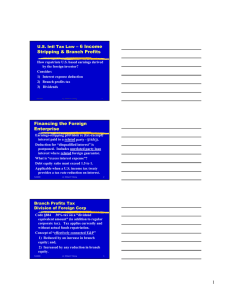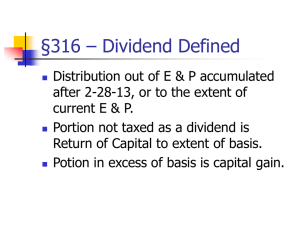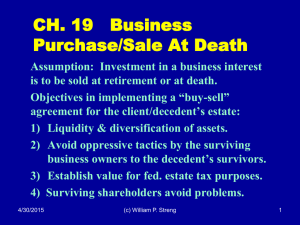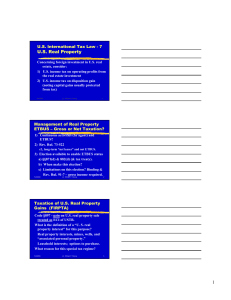Chapter 4 Nonliquidating Distributions
advertisement
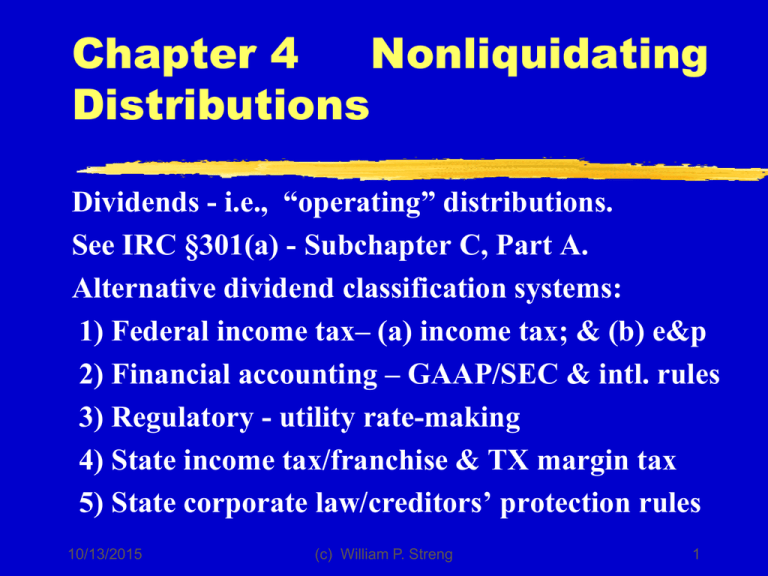
Chapter 4 Nonliquidating Distributions Dividends - i.e., “operating” distributions. See IRC §301(a) - Subchapter C, Part A. Alternative dividend classification systems: 1) Federal income tax– (a) income tax; & (b) e&p 2) Financial accounting – GAAP/SEC & intl. rules 3) Regulatory - utility rate-making 4) State income tax/franchise & TX margin tax 5) State corporate law/creditors’ protection rules 10/13/2015 (c) William P. Streng 1 Dividend Payments Alternatives for Corp. A. Ordinary course of business 1. cash distribution 2. property – a) appreciated/depreciated b) capital gain/ordinary income property c) installment obligations 3. distribution of corporation's own notes 4. distribution of corporation's own stock B. Extraordinary course of business 10/13/2015 (c) William P. Streng 2 Tax Definition of a “Dividend” p.149 §301(c) Income Tax – Distribution Ordering Rules 1) §301(c)(1) - dividend distributions. 2) §301(c)(2) - recovery of tax basis. 3) §301(c)(3) - realization of capital gain. §316 - Dividend distribution sourcing: 1) accumulated “earnings & profits,” or 2) current “earnings and profits” (i.e., the "nimble dividend" rule). 10/13/2015 (c) William P. Streng 3 Dividend Taxation to the Individual Shareholder p.151 §1(h)(11) - taxation at capital gains rates (20%) to individual dividend recipient. “Permanent” rate. Must be “qualified dividend income”, i.e., received from: (1) a domestic corporation, or (2) a foreign corporation (if satisfying specified criteria). §1(h)(11)(C)(i)(II) & Notice 2011-64. Must satisfy holding period requirement (60 of 121). “Dividends” received from a “money market fund”? Not eligible for the 20% tax rate. Why? Does the 20% dividends rate incentivize economy? 10/13/2015 (c) William P. Streng 4 Corporate Dividend Policy p.153 Why pay (or not pay) dividends? - Retain earnings for future investments? - Reduce borrowing costs through the retention of corporate earnings? - Pay out earnings for a closely held corp. to shareholders, but only in a deductible form? - Any effect on institutional shareholders? Cf., better use of capital after corporate distributions have been made to shareholders? 10/13/2015 (c) William P. Streng 5 Defining “Earnings and Profits” for Tax Purposes P. 155. Code §312 concerns E&P concepts. Objective: Identify a cash equivalent amount available for distribution to owners/shareholders; premised upon true economic results & not on the “taxable income” base. Choices for identifying “dividend” status: 1) Taxable 2) E&P 3) Earned surplus; income GAAP concepts (federal tax) 10/13/2015 (c) William P. Streng 6 Adjustments to Taxable Income for E&P Amount I. E&P Additions for Income Items (p.156) - municipal bond income - §103 - life insurance proceeds (above tax basis?) - federal tax refunds – this tax is not deductible II. Deduction Addback Items to E&P (p.156) - dividends to the corporate shareholder from another corp. & previously protected by a dividends received deduction (DRD) for FIT purposes. 10/13/2015 (c) William P. Streng 7 E&P adjustments, continued III. Nondeductible amounts which do reduce the E&P amount (p.157) - Federal income taxes paid by the corp. - Disallowed losses - §265 and §267. - Charitable contributions above the % limit. - Disallowed T& E expense - §274. These are “cash out of pocket” items but are not deductible for FIT purposes. 10/13/2015 (c) William P. Streng 8 E&P adjustments, continued §312(k)&(n) IV Timing Adjustments for E&P (p.157). A. Income components, e.g., §453 or the (if available?) “completed contract” method. P.158. B. Depreciation components, e.g., §312(k)(3)(A) & §168(g)(2). Use alternative depreciation system & not ACRS. Also, §179 deduction amount to be amortized over 5 yrs. for E&P. C. Inventory – FIFO method; not LIFO. NOTE: (i) No statute of limitations on an E&P determination & (ii) No PLR re E&P status. 10/13/2015 (c) William P. Streng 9 Problem p.158 Income &E&P Determinations I. Determining Taxable Income Gross income Sales (gross) profits Dividends from corp. Long-term capital gain Total gross income 10/13/2015 (c) William P. Streng 20,000 5,000 2,500 27,500 10 Net Income Determination continued, p.169 Deductions Employee salaries DRD - 70% of $5,000 (§243) Depreciation LTCL (limited to gain) Total deductions Total taxable income (27,500 less 19,050) 10/13/2015 (c) William P. Streng 10,250 3,500 2,800 2,500 19,050 8,450 11 E&P Determination Adjustments Taxable income 8,450 Increases to E&P: Tax-exempt interest 3,000 Dividends received deduction 3,500 Depreciation (2,800 less 1,000) 1,800 (2,000 SL depreciation x ½ year) Total increases to E&P 8,300 10/13/2015 (c) William P. Streng 12 E&P Determination adjustments, cont. Decreases to E&P Amount Excess LTCL Estimated federal taxes paid Total decreases Earnings and profits total (8,450 + 8,300 less 3,300) 10/13/2015 (c) William P. Streng 2,500 800 (3,300) 13,450 13 Cash Distributions p.158 Income Tax Effects 1) Cash distribution to the shareholder is a “dividend,” but the dividend amount (ord. income for FedTax) is limited to the distributing corporation's “E&P” amount. See Code §301(c). 2) Result to the corporation: Reduction of E&P by the distribution amount, limited to the amount of E&P (i.e., cannot create a negative amount in E&P account). 3) What E&P allocation procedures (next slide)? 10/13/2015 (c) William P. Streng 14 Allocation Procedures See Rev. Rul. 74-164 p.159 1) Current e&p is allocated proportionately to all current year distributions. Allocate first. 2) Accumulated e&p is allocated chronologically to distributions during the year (starting with the first distribution during the year). 3) Current loss is allocated pro rata against the accumulated e&p available on the date of the distribution, unless the date of the loss is specifically earmarked. 10/13/2015 (c) William P. Streng 15 Problem (a) p.162 Distribution Exceeding E&P $10,000 tax basis to Ann for Pelican stock. Pelican has $5,000 of current e&p and no accumulated e&p & distributes $17,500 . Holding these shares less than one year? Result: a) $5,000 dividend - §301(c)(1) b) $10,000 return of capital - §301(c)(2); then, zero basis for the stock. c) $2,500 capital gain- §301(c)(3). STCG? 39.6%? Pelican's e&p is reduced to zero - §312(a)(1). 10/13/2015 (c) William P. Streng 16 Problem (b) p.163 “Nimble Dividend” Rule Effect $15,000 accumulated deficit in e&p from prior year and $10,000 of current e&p & corp. distributes $10,000 currently. Result: the entire $10,000 distribution is a dividend to Ann under the "nimble dividend" rule (sourced from current e&p). Pelican continues to have a $15,000 deficit in its e&p (i.e., no adjustments to e&p account). No current e&p exists after the distribution). 10/13/2015 (c) William P. Streng 17 Problem (c) Distributions & Mid-Year Stock Partial Sale Facts: (i) $10,000 of accumulated e&p before year two (to be allocated chronologically) and (ii) $4,000 of current e&p (pro-rated allocation). 1) April 1 distribution of $10,000. 2,000 (pro rata portion of 4,000 current E&P); & then 8,000 of the 10,000 accumulated E&P (1st come/1st served) is received as a dividend distribution. continued 10/13/2015 (c) William P. Streng 18 Problem (c) continued p. 163 2) October 1 distributions of $5,000 & $5,000 to (now) two shareholders. $2,000 current E&P (1,000 each shareholder). $2,000 remaining accumulated E&P (10,000 less 8,000 on April 1) allocated 1/2 (1,000) to each shareholder. Each has a $3,000 capital return (5,000 less 1,000 and less 1,000). Zero E&P of corp. after these distributions. 10/13/2015 (c) William P. Streng 19 Problem (c) continued p. 163 3) On July 1 shareholder sells 1/2 of stock for 15k. What basis, including impact of the October transaction? a) Original basis of $10,000 & sold ½ equals $5,000 tax basis to this sale. b) Also, less 1,500 basis (½ of the $3,000 tax basis return received on 10-1). Equals: 15,000 less 6,500 (5,000 plus 1,500) or 8,500. 10/13/2015 (c) William P. Streng 20 Problem (d) Current Year Deficit p.163 Pelican has a $10,000 deficit in Year Two. 1) April 1 distribution of $10,000 to Ann 1/4th of current 10,000 loss (2,500) is allocable to the April 1 distribution of 10,000 (no earmarking); 7,500 dividend (reducing e&p from prior year to zero) & 2,500 return of capital to Ann. Ann’s stock basis is reduced from 10,000 to 7,500. continued 10/13/2015 (c) William P. Streng 21 Problem (d) Current Year Deficit p.163 2) October distribution of $5,000 to Baker (No e&p & therefore, no dividend) Purchase basis on July 1 15,000 Basis reduced – 10-1 distribution 5,000 Baker’s remaining basis 10,000 continued 10/13/2015 (c) William P. Streng 22 Problem (d), cont., p.163 Option One (dividends 1st) 2) October 1 distribution of $5,000 to Ann. No current e&p & no acc. e&p. Ann’s results: Option(s): Basis is: 7,500 3,750 (1/2?) Less: distribution 5,000 5,000 Result: 2,500 1,250 (basis) (gain) 3) July 1 sale of 1/2 stock for 15k: (a) 11,250 gain (less 3,750 basis) or (b) 13,750 gain (15x less 1/2 of 2,500 or 1,250). 10/13/2015 (c) William P. Streng 23 Problem (d), cont., p.163 Option Two (chronological) 2) July 1 - Ann sells 1/2 of stock for 15k. (15,000 less 3,750 (1/2 basis) = 11,250 gain) 3) October 1 distribution of $5,000 to Ann. No current e&p & no accumulated e&p. Treatment to Ann: Less: distribution 5,000 Basis is: 3,750 Result: 1,250 gain 10/13/2015 (c) William P. Streng 24 Distributions of Property to Shareholders p.163 Prior history: General Utilities doctrine, i.e., no gain was to be recognized when appreciated property was distributed in a non-liquidating distribution to shareholders. Earlier: Not treated as a sale, but certain limitations applied, such as the tax benefit rule and substance over form. See Code §311(a)(2). Non-recognition was repealed in TRA-86. 10/13/2015 (c) William P. Streng 25 Distributions of Property to Shareholders, cont. p.163 Current income tax issues to the corporation upon a property distribution: 1) Income (loss?) recognition to the distributing corporation upon a distribution in kind? Gain for excess of FMV over tax basis is to be recognized. §311(b). Cf., §311(a)(2) re no loss recognition. 2) What effect on E&P from (a) this gain recognition to the corporation and (b) the distribution event? See §312(b). E&P is increased. 10/13/2015 (c) William P. Streng 26 Distributions of Property to Shareholders, cont. p.167 Effect when the distributed property is subject to a liability attached? See Reg. 1.312-3 re reduction of the E&P decrease - i.e., “proper adjustment.” Note (later): the dividend amount to the shareholder is limited to the net FMV of the property distributed. 10/13/2015 (c) William P. Streng 27 Corporate Distributions of its Own Obligations p.167 Treatment of the corporation: 1) §311(b)(1)(A) - gain recognition is required by a corporation on the distribution of appreciated property “other than an obligation of such corporation”. 2) The corporation's e&p is reduced by the principal amount of the obligation (or, alternatively, the “issue price” - if a lesser value - i.e., where the debt has OID). Code §312(a)(2). 10/13/2015 (c) William P. Streng 28 Distributions of Property to the Shareholders p.167 Income tax issues to the shareholder upon a property distribution: 1) Dividend treatment to the shareholder receiving the property as a distribution (for the net fmv of the property)? Yes, as reduced by any liabilities (assumed or attached to the property). 2) Tax basis to the shareholder for the property received in the distribution? FMV of the property (but, not reduced by any assumed/attached debt; cf., Crane decision). 10/13/2015 (c) William P. Streng 29 Corporation’s Own Obligations Received Treatment to Shareholder distributee: 1) dividend to the shareholder for the fair market value of the obligation received (i.e., not the "face value" of the instrument). 2) tax basis to the shareholder for the obligation received as a dividend is the fair market value of that obligation when received by the shareholder. 3) Possible future interest income/OID to the shareholder. 10/13/2015 (c) William P. Streng 30 Problem (a) Appreciated Inventory p.167 Zane purchased Sturdley stock for $8,000. Sturdley has $25,000 accumulated e&p and no current e&p. Distribution of inventory is made: $20,000 FMV and $11,000 basis for inventory. 1) Sturdley has recognized ordinary gain of $9,000. 2) $9,000 gain = current e&p for Sturdley. 3) The entire $20,000 is dividend to Zane. (9,000 current e&p and 11,000 of acc. e&p.) cont. 10/13/2015 (c) William P. Streng 31 Problem (a), continued p.168 4) Tax basis to Zane for the inventory received: $20,000 (FMV) - §301(d). Holding period? 5) Remaining E&P is $14,000: 25,000 prior E&P, plus 9,000 current E&P, less 20,000 distribution, equals 14,000. §312(b)(2). Not considering the impact of the federal income tax liability on the $9,000 gain realized on Sturdley’s inventory distribution. 10/13/2015 (c) William P. Streng 32 Problem (b) p.168 No Pre-Distribution E&P Sturdley has no accumulated e&p and no current e&p. Distribution of the appreciated inventory: $20,000 FMV and $11,000 basis. 1) Distribution produces to the corporation: $9,000 gain (ord. income) & $9,000 current e&p (less any income tax on the $9,000 gain). 2) Result to the shareholder - Distribution of the $20,000 inventory: 9,000 dividend, 8,000 tax basis recovery for shares, & 3,000 cap. gain. §301(c). 10/13/2015 (c) William P. Streng 33 Problem (c) Mortgaged Property p.168 Distribution of land: $20,000 FMV; 11,000 basis; subject to 16,000 mortgage debt. 1) $9,000 income is realized by corporation on the land distribution. §311(b)(1). 2) E&P is increased by 9,000 - §312(b)(1). 3) Distribution to shareholder is $4,000 (20,000 FMV less the 16,000 debt). §301(b)(2). Dividend income is 4,000 - adequate e&p exists. FMV basis to the shareholder for the land. 10/13/2015 (c) William P. Streng 34 Problem (d) Depreciated Property p.168 $25,000 acc. e&p and 15,000 current e&p. Corp. distributes depreciated land with a 20,000 fmv and a 30,000 tax basis. 1) §311(a) - no recognition of loss occurs. 2) 20,000 dividend distribution (property fmv) is made to the shareholder. §301(b)(1). 3) 20,000 tax basis to shareholder - §301(d). 4) E&P is reduced by $30,000 - §312(a)(3) & then 10,000 E&P for the future (25 + 15 less 30 = 10). 10/13/2015 (c) William P. Streng 35 Problem (d), cont. p.168 Alternate: Property Sale First, a sale of the depreciated property: 10,000 loss reduces corporation’s (1) taxable income and (2) current E&P (15 less 10 equals 5). Distribution of 20,000 cash produces 20,000 dividend; acc. E&P is reduced to 10,000 (25,000 plus 5,000 current less 20,000). But, shareholder might want the land for other (e.g., sentimental) reasons. 10/13/2015 (c) William P. Streng 36 Problem (e) p.168 Different E&P & FIT tax bases Assume $25,000 acc. e&p and distribution of used machinery - 10,000 fmv; zero income tax basis; 2,000 E&P tax basis (five year property and seven year class life). Purchased for $14,000 on July 1 of year one. Distribution was made on January 1 of year 7. Separate depreciation expense schedules for: (i) income tax, and (ii) the E&P calculation. Reg. §1.312-15(d). continued 10/13/2015 (c) William P. Streng 37 Problem (e) cont., Distribution effects p.168 1) 10,000 ordinary income to Corp. for taxable income purposes - §311(b)(1) & §1245. 2) 8,000 income for e&p purposes upon the distribution of the asset. E&P tax basis is 2,000 (14,000 cost less 12,000 depreciation). 3) Dividend distribution of 10,000 to shareholder. 4) E&P is reduced by 10,000 - §311(a) & (b). 5) Remaining E&P? 25 + 8 less 10 = 23k. 6) 10,000 FMV basis for asset to shareholder. 10/13/2015 (c) William P. Streng 38 Constructive Dividends Reg. §1.301-1(j) p.168 Types of disguised dividend distributions: 1) Excessive compensation paid to shareholders. 2) Personal expense reimbursements. 3) Excessive rent for corp. use of owner’s property. 4) Excessive interest paid on corp. debt, or interest is paid on debt which really constitutes equity. 5) Bargain sales of corp. property to shareholders. 6) Interest-free loans made to shareholders. §7872. 10/13/2015 (c) William P. Streng 39 Nicholls, North, Buse Co. v. Commissioner p.168 Corporate ownership of yacht and personal use of yacht by a son of the majority owner. 1) Constructive dividend for personal use. 2) Use was imputed to the father (not son). 3) Amount of the dividend (to father): a) Not the purchase price of the yacht. b) But, value of the personal use of the yacht for the tax year in issue. 10/13/2015 (c) William P. Streng 40 Constructive Dividends & 20% Dividends Tax Rate Taxation of dividends to the shareholder at the rate of 20% (after ATRA-2012). Cf., maximum income tax rate of 39.6% for compensation income received (plus 3.8% ACA tax). Better to have excess compensation treated as a constructive dividend rather than as compensation? Consider also the social security tax (a 12.4% tax on maximum $118,500 for 2015, plus 2.9% unlimited medicare tax) and related considerations for compensation (in lower compensation ranges). 10/13/2015 (c) William P. Streng 41 The Dividends Received Deduction - §243 p.174 Availability of the §243 “dividends received deduction” to the recipient corporation: 1) 70% - corporate investment situations; (10.5% effective tax rate, i.e., 30% x 35%) 2) 80% DRD if 20% to 80% corporate ownership of another corporation’s stock; 3) 100% DRD if the dividend is paid to an “affiliated group” member (i.e., above 80%). Objective: reduce the cost of a 2nd corp. level tax. 10/13/2015 (c) William P. Streng 42 Anti-Avoidance Limitations on the DRD p.175 A) Limits on a corporation’s §243 “dividends received deduction”: 45 of 91 day holding period requirement - §246(c)(1)(A). Longer holding period (90 days of 181 day period) for preferred stock. Objective: must hold stock & have market risk to enable DRD. Note re 2003 (2013) tax legislation for individuals: A separate holding period rule limit (60 days in 120 day period) to enable the 20% (prior 15%) dividend tax rate provided in §1(h)(11)(B)(iii)(I). 10/13/2015 (c) William P. Streng 43 Anti-Avoidance Limitations cont. §1059 p.176 B. Treatment to corp. of extraordinary dividends, i.e., “dividend stripping” transactions: 1) tax basis reduction (for nontaxed portion) and gain recognition after tax basis recovery. §1059. 2) “extraordinary dividend” occurs when 10% plus of tax basis (or FMV) amount (5% for preferred stock) is received in an 85 day (or shorter) period. Not in the 100% DRD situation. Note: 2003 (2013) tax legislation - extraordinary dividend rule for individuals. §1(h)(11)(D)(ii). 44 10/13/2015 (c) William P. Streng Anti-Avoidance Limitations cont. p.178 C. Debt financed portfolio stock limitation on the dividends received deduction - §246A. Interest expense deduction + DRD both acceptable? Debt incurred must be attributable to “portfolio stock” (i.e., less than a 50% ownership interest). Proportionate disallowance occurs if portfolio debt only partially finances stock acquisition. Reduction in DRD is limited to the amount of interest expense deduction allocable to the dividend. Direct attribution to debt (what if “indirect” debt?) 10/13/2015 (c) William P. Streng 45 Anti-Avoidance Limitations cont. p.192 D. §301(e) – downward e&p adjustments. Objective: To limit the DRD (for 20% plus corporate shareholders), e.g.: 1) when E&P is increased because of slower depreciation schedules for E&P purposes (cf., the usual §§167/168 depreciation formula), or 2) installment sale recognition occurs for E&P but not for taxable income purposes (i.e., postponed). 10/13/2015 (c) William P. Streng 46 Problem p.181 DRD Eligibility - 45 day rule Investor corporation purchases 1,000 shares of publicly held common stock for $15,000 on June 3, collects $1,000 dividend on June 12, and sells the stock for $14,000 on June 15. Anticipation: 1,000 dividend & 70% DRD = 300 net ordinary dividends, plus 1,000 STCL. Problem (a): §246(c) results in denial of the DRD. 1) $1,000 ordinary income (not $300 with DRD), and 2) $1,000 STCL on sale of stock. 10/13/2015 (c) William P. Streng 47 Problem Stock Held Longer p.181 (b) Stock is retained until December 1 (rather than being sold on June 15): The §246(c) DRD limitation would not apply since the 45 day minimum holding period requirement (during the specified 90 day period) has been satisfied in this situation. 10/13/2015 (c) William P. Streng 48 Problem p.181, cont. Dividend Stripping? (c) Publicly Held pays a second $1 per share dividend ($1,000) on August 15 (60 days later). §1059(c)(3) becomes applicable and a $2,000 total dividend is treated as having been received. The total dividends exceed 10 percent of the tax basis for the stock (since tax basis is $15,000 and the total dividends are $2,000). Tax basis is reduced by the nontaxed portion of the extraordinary dividend (i.e., $1,400 – 70% DRD). 10/13/2015 (c) William P. Streng 49 Problem p.181 cont. Extraordinary Dividend? (d) Dividends received total $2 per share but stock is held for 25 months before being sold. Under §1059(a) stock must be held for more than two years before the dividend announcement date to avoid §1059 application. The $2,000 dividend would be an extraordinary dividend under §1059(c). Basis is to be reduced by the nontaxed portion (2,000 less 600 (taxed) = $1,400). 10/13/2015 (c) William P. Streng 50 Problem Portfolio Debt? p.181 cont. (e) Investor (i) purchases stock for $15,000 by (ii) borrowing $15,000 secured by the stock, (iii) paid $1,200 interest expense during the year and (iv) received $1,000 dividends. Under §246A(d)(3) the $15,000 is “portfolio indebtedness” with respect to the stock. Under §246A(a) the §243 deduction is 70 percent of zero (100% less 100% = 0). The $1,000 dividend is fully taxable. 10/13/2015 (c) William P. Streng 51 Problem p.181 cont. Partial Portfolio Debt (f) Investor borrowed only $7,500 of the $15,000 total cost (i.e., 1/2) to acquire the stock. The “average indebtedness percentage" would then be only 50% of purchase price. §246A(d). Under §246A(a) the dividends received deduction is 70% times 50% (or 35%). Of the $1,000 dividend received the DRD would be available for 35 percent of the total $1,000 dividend (or $350). 10/13/2015 (c) William P. Streng 52 Dividends Paid in Bootstrap Sales p.181 TSN Liquidating Corp. v. U.S., p.181 Assets are distributed by the subsidiary to parent corp. immediately prior to the sale of stock of sub. Issue: (i) dividend (& DRD available)? or (ii) sale of stock proceeds (if stock sale - §453 installment sales treatment was not then available because of then applicable 30 percent limit on the initial payment in installment sales)? Held: DRD is available (dividend before the sale). 10/13/2015 (c) William P. Streng 53 Problem, p.193 Dividend Substance vs. Form Strap Corp as the sole shareholder of X, Inc. X stock held more than two years. Therefore, no §1059 applicability. Strap basis of $150,000 in X stock. Boot willing to purchase X stock from Strap for $500,000. X has $100,000 cash. X will distribute $100,000 to Strap. Strap will then sell X stock to Boot for $400,000. continued 10/13/2015 (c) William P. Streng 54 Problem, p. 193 Strap would receive a 100% DRD - if the form of the transaction is respected. Strap’s LTCG would then be $250,000 (400 less 150 tax basis). Here: the unwanted asset is fungible cash - and is the distribution part of the sale? Stronger step transaction argument for IRS? Dividend excluded if a consolidated return. continued 10/13/2015 (c) William P. Streng 55 Problem p.193, cont. If Strap is an individual: Would IRS argue for dividend treatment since the $100,000 dividend would be treated as ordinary income (subject to tax at ordinary income tax rate, rather than the 20% rate for capital gains). But, also a 20% rate for dividends received by individuals. Planning in this context: have the individual redeem $100,000 worth of stock immediately before the sale to Boot? 10/13/2015 (c) William P. Streng 56




